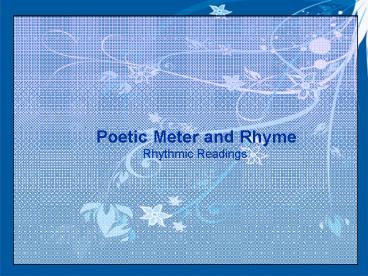Poetic Meter and Rhyme - PowerPoint PPT Presentation
1 / 16
Title:
Poetic Meter and Rhyme
Description:
Poetic meter is a generally regular pattern of stressed and ... On the twink ling grass. from 'To a Skylark' by Percy Bysshe Shelley. Basic Metrical Feet ... – PowerPoint PPT presentation
Number of Views:3232
Avg rating:5.0/5.0
Title: Poetic Meter and Rhyme
1
Poetic Meter and Rhyme
- Rhythmic Readings
2
What Is Poetic Meter?
- Poetic meter is a generally regular pattern of
stressed and unstressed syllables. - It is like the rhythmic beat that draws you into
music.
Tyger! Tyger! burning bright In the forests of
the night, What immortal hand or eye Could frame
thy fearful symmetry? from The Tyger by William
Blake
3
What Is a Poetic Foot?
- A foot is a meters basic unit. A foot consists
of one stressed syllable and usually one or more
unstressed syllables.
4
Basic Metrical Feet
- The five basic metrical feet are
- iambunstressed syllable followed by a stressed
syllable (da DAH)
- trocheestressed syllable followed by an
unstressed syllable (DAH da)
5
Basic Metrical Feet
- spondeetwo stressed syllables (DAH DAH)
- anapesttwo unstressed syllables followed by a
stressed syllable (da da DAH)
6
Basic Metrical Feet
- dactylone stressed syllable followed by two
unstressed syllables (DAH da da)
7
Counting Metrical Feet
- To describe the number of feet in a line of
poetry, use the following terms. - dimetertwo metrical feet per line
- trimeterthree metrical feet per line
- tetrameterfour metrical feet per line
- pentameterfive metrical feet per line
- hexametersix metrical feet per line
8
Scansion Analyzing Poetic Meter
- Scansion is the act of analyzing poetic meter. To
scan a poem, follow these steps.
- Step 2 If possible, identify the type of foot
used most often in each line (iamb, trochee,
spondee, anapest, dactyl).
9
Scansion Analyzing Poetic Meter
- Step 3 If the poem has a regular meter, count
the number of feet per line to determine the name
of the metrical pattern.
- The metrical pattern consists of the name of the
meter followed by the number of feet. - iambic pentameter, trochaic hexameter, dactylic
trimeter, etc.
10
Scanning a Poem
Had we but world enough, and time, This coyness,
Lady, were no crime. We would sit down, and think
which way To walk, and pass our long loves
day. from To His Coy Mistress by Andrew Marvell
11
What Is Rhyme?
- Rhyme is the musical quality produced through the
repetition of accented vowel sounds and all
sounds following them in words that are close
together in a poem.
The fair breeze blew, the white foam flew, The
furrow followed free We were the first that ever
burst Into that silent sea. from The Rime of the
Ancient Mariner by Samuel Taylor Coleridge
12
Types of Rhymes
- End rhyme occurs at the ends of lines.
Tyger! Tyger! burning bright In the forests of
the night from The Tyger by
William Blake
- Internal rhyme occurs within lines.
Out of the sea came he! And he shone bright, and
on the right from The Rime of the Ancient
Mariner by Samuel Taylor Coleridge
13
Types of Rhymes
- Approximate rhyme occurs when words sound similar
but do not rhyme exactly.
Willows whiten, aspens quiver, Little breezes
dusk and shiver Through the wave that runs
forever By the island in the river from The
Lady of Shalott by Alfred, Lord Tennyson
14
Identifying a Rhyme Scheme
- The rhyme scheme is the pattern of rhymed lines
in a poem. Identify the rhyme scheme by giving
each new end rhyme a new letter.
Whateer the theme, the Maiden sang As if her
song could have no ending I saw her singing at
her work, And oer the sickle bending I
listend, motionless and still And, as I
mounted up the hill, The music in my heart I
bore, Long after it was heard no more. from
The Solitary Reaper by William Wordsworth
15
What Have You Learned?
Match each term to its definition.
Foot Meter Iamb Rhyme
________ The basic unit of meter ________
Unstressed syllable followed by a stressed
syllable ________ A generally regular pattern of
stressed and unstressed syllables ________
Repetition of accented vowel sounds and all
sounds following them in words that are close
together
16
The End































